Fire and Rescue Service Wildfire Operational Guidance
This guidance has been produced to give fire and rescue service personnel an additional understanding and awareness of the phenomenon of wildfire. It examines the hazards, risks and controls relating to Fire and Rescue Service personnel, the personnel of other agencies and members of the public at Incidents of wildfire. It also provides a point of reference for those who may be called upon to plan for wildfire events and for those incident commanders and personnel responding to such incidents.
8C Generic Standard Operating Procedure
Introduction
It is useful to see the emergency incident response phases in the context of the typical stages of an incident as referred to in Volume 2 Fire Service Operations Incident Command Operation Guidance and the Guide - Dynamic Management of Risk at operational Incidents. This is shown below.
| Stages of an Incident (Dynamic Management of Risk) |
ICS Decision Making Model Links |
GSOP Response Phases |
|---|---|---|
| 1. Mobilising and |
||
| Initial Stage |
|
2. Arriving and Gathering Information |
| Development Stage |
|
3. Planning the Tactical Plan |
|
4. Implementing the Tactical Plan |
|
|
5. Evaluating the Tactical Plan |
|
| Closing Stage |
6. Closing the Incident |
The generic standard operating procedure (GSOP) has been derived by breaking down an incident into six clearly identified phases which has been taken directly from the decision making model.
The purpose of this section is to cover possible actions that may need to be undertaken at each of the six stages of the incident and then offer up some possible considerations that the Incident Commander and other Fire and Rescue personnel may find useful in tackling the challenges and tasks that may be faced at a wildfire incident.
The GSOP is not intended to cover every eventuality however it is a comprehensive document that can be used by planning teams, who need to write standard operating procedures and responding personnel alike.
Further detailed and tactical information on specific wildfire related hazards are covered throughout this document.
The decision making model comprises of two major components; these are the deciding and acting stages.
In seeking to resolve a wildfire incident the Incident Commander will use their knowledge and experience to identify the objectives to be achieved and formulate an appropriate tactical plan of action.
Emergency Incident Response Phase
| 1 |
Mobilising and En-route |
|---|---|
| 2 |
Arriving and Gathering Information |
| 3 |
Formulating the Tactical Plan |
| 4 |
Implementing the Tactical Plan |
| 5 |
Evaluating the Tactical Plan |
| 6 |
Closing the Incident |
Phase 1: Mobilising and En-route
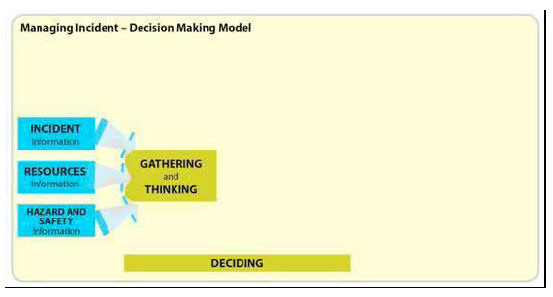
All relevant information should be gathered during the pre-attendance phase of an incident.
| Phase 1 - Actions Mobilising and En-route |
|
|---|---|
| 1.1 |
Initial call handling |
| 1.2 |
Assess the level and scale of the incident |
| 1.3 |
Mobilise appropriate resources |
| 1.4 |
Access incident specific information en-route |
| 1.5 |
Notify relevant agencies |
Considerations
1.1 Initial call handling
As with any incident the handling of the initial call is of critical importance to ensure that the correct predetermined attendance is mobilised. In handling the call the mobilising centre operator will need to gather as much information from the caller(s) as possible. If there is any doubt about the size or potential scale of the incident the predetermined attendance should be scaled up rather than down.
In determining the correct predetermined attendance the following may be considered.
- Informed call coming from a reliable source, such as a land manager, land owner, member of a fire group or the Police.
- Uninformed call, vague call from a member of the public, or suspected hoax call.
- A number of calls in relation to the same location or incident.
1.2 Assess the level and potential scale of the incident
Fire and Rescue Service's mobilising controls should try to obtain information regarding the size, potential scale and location of the incident prior to and during the mobilisation of Fire Service resources. This will provide quality information for the Fire and Rescue Service personnel and response partners who may be first on the scene.
Gathering information about incidents that often occur in very remote areas is difficult and Fire Services will benefit from assessing how this can be best achieved in their area.
Information may be obtained from.
- Persons in attendance at the scene
- Pre-arranged lists of contacts that have detailed knowledge of the local geography and conditions, these may include private land owners/managers, foresters, farmers, National Parks rangers, military personnel etc.
- Fire group members that work or are located near to the incident
- The caller or subsequent callers
- Local knowledge of Fire Service Personnel or their partners
- Observations at the scene
1.3 Climatic conditions
Importantly information should be gathered on the current, and forecasted, weather conditions.
This should include specific information on the following:
- Wind speed and direction
- Temperature
- Relative humidity
- Precipitation
- Atmospheric stability
1.4 Mobilise appropriate resources
During a protracted wildfire period, it is likely that some Fire and Rescue mobilising controls will face a significant increase in the number and scale of incidents requiring the attendance of Fire and Rescue Service resources. During such demanding periods arrangements should be made to co-ordinate the Fire and Rescue Service response and manage any Fire Group or partner involvement.
Fire and Rescue control centres should utilise any site specific plans to enhance mobilising information given to personnel, this is particularly important when the exact location or scale of the incident is not known and where it may be decided to mobilise to a geographical area or a pre-determined rendezvous point.
Fire and Rescue control centres may be required to activate pre-arranged mobilisation solutions including a collaborative response, sometimes involving other agencies or partners.
Determining the level of response to a wildfire can depend on a number of situations including:
- Size or potential scale of the incident
- Fuel types
- Potential Fire Spread
- Reported fire behaviour
- The possible involvement of infrastructure
- Urban Interface fires
- The prevailing weather conditions
- The remoteness of the incident location
- Possible environmental impact
Consideration should be given for the need to mobilise, at an early stage:
- Specialist wildfire vehicles and equipment
- Trained and experienced Fire and Rescue Service personnel
- Specialist wildfire officers including subject matter advisers
- Specialist wildfire teams
Local arrangements may exist whereby specialist vehicles, equipment or personnel are available via partnerships with land management agencies and landowners.
1.5 Access incident specific information en-route
Mobilised personnel should access site/incident specific information from mobile data systems, or hardcopy fire plans to clarify:
- Appropriate routes to be taken to the scene
- Rendezvous points
- Site specific pre-determined plans
- Pre-determined collaborative arrangements
- Appropriate approach roads and tracks
Mobilised personnel should request information on, and think about, the hazards they will face and the control measures that will need to be put in place.
1.6 Notify Relevant Agencies
Fire and Rescue Services should maintain contact details for all wildfire risk sites within their service area, and should establish robust working arrangements with relevant local and National organisations.
On most occasions land managers/owners will be aware of any incident that is taking place on their property; however it is good practise for Fire and Rescue control centres to inform/confirm with the relevant land manager/owner that a response has been made by their service.
Resolving some wildfires will involve a multi-agency effort: where appropriate, Fire and Rescue Service control centres should share information with other relevant agencies.
Fire and Rescue control centres should have early dialogue with any agency that may be involved, be of assistance or may be affected by a wildfire incident. The scope of this requirement will depend on the location and size of the incident and the impact it may have on local communities, infrastructure and the environment.
Consideration should be given to the following:
- The nature of the incident
- The hazards involved
- On-going actions
- Potential scale of the incident
- The level of support required
Phase 2: Arriving and Gathering Information
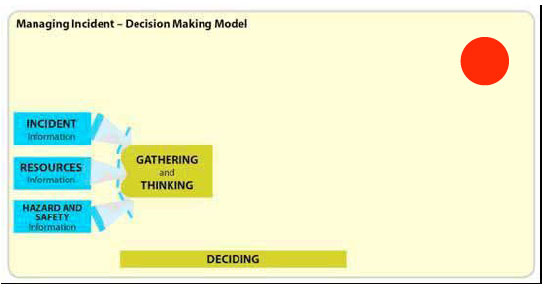
The initial FRS attendance should gather sufficient information to allow an effective evaluation of the situation.
| Phase 2 - Actions Arriving and Gathering Information |
Incident information Resource information Hazard and safety information |
|---|---|
| 2.1 |
Confirm location of incident and incident type |
| 2.2 |
Approach the incident safely |
| 2.3 |
Assess hazards and risks and the implementation of an inner cordon |
| 2.4 |
Cordon considerations |
| 2.5 |
Liaison with other co-responders |
| 2.6 |
Consider involvement of dwellings or other property |
| 2.7 |
Estimate the resource requirements |
| 2.8 |
Implement the Incident Command System (ICS) |
| 2.9 |
Investigation and recording |
Considerations
2.1 Confirm location of incident and incident type
The first Fire and Rescue Service personnel in attendance will need to confirm an accurate location and provide information on the following:
- The exact location of the incident given using a six figure map reference
- The extent of the incident
- Potential fire spread
- Rendezvous points
- Safe access and egress routes
- Best approach routes to be taken and nature of the ground conditions
This information will be broadcast to on-coming Fire and Rescue Service appliances and mobilising control centres, other agencies and partners should be informed via fire control centres.
2.2 Approach the incident safely
Wildfires can often occur at remote locations on terrain that is both difficult and hazardous to operate on. Whilst mobilising to an incident it is important that any relevant information is accessed, this should include site specific plans and topographical mapping systems. Any additional information required should be requested, this will allow an assessment of the difficulties and hazards that may be confronted.
The following points may have to be taken into consideration during the approach to a wildfire incident and may assist in assessing the suitability of response routes and rendezvous points (RVPs) to be used.
- The position of access routes and RVPs in relation to potential fire spread
- The surrounding fuel types
- The topography
- Time of day
- Weather conditions
- Which roads or tracks are suitable for Fire and Rescue Service vehicles
- Whether there are suitable escape routes and passing points
- The presence of turning areas
- The presence of locked gates or other obstacles that may block access or egress
- Parked vehicles or machines
Driver considerations:
- Any route taken should be pre-planned and understood
- When approaching an incident drivers must use a safe speed
- Consideration should be given to the nature and condition of the surface
- Extreme care should be taken to avoid surfaces that will result in the vehicle becoming immobile, this includes ATVs
Approaching the incident on foot:
At many wildfire incidents it is impossible to get to the scene of operations by vehicle and it is necessary to travel some distance by foot.
The following should be considered:
- Where possible recognised paths or tracks should be used
- FRSs should assess the level of training and awareness required to ensure personnel can traverse open landscape safely
- Appropriate navigation equipment must be utilised
- The route should be pre-planned and safe
- The LACES safety protocol should be adopted
2.3 Assessing the hazards and risks and the implementation of control measures
At a large wildfire, FRS incident commanders may have difficulty in obtaining sufficient quality information to enable them to formulate an effective initial plan. Incident commanders must ensure that whenever possible they take up a position from where they can observe the whole incident and the surrounding area. At larger incidents this may involve the use of an aircraft to allow assessment of the hazards from above.
As well as establishing an understanding of the current situation they must consider the potential changes that may occur in the future.
In assessing the demands of an incident and reaching a decision regarding the application of control measures, the incident commander should pay particular attention to the following:
- The initial extent and size of the incident
- The fuels available to burn
- The shape of the topography
- The influence of weather conditions on the wildfire environment
- Pre-incident weather conditions
- The expected fire behaviour
- The potential the fire has to spread across the landscape and the changes to fire behaviour that this will bring
- The restrictions to fire spread that can be used to contain a fire (control lines)
- Resources available at the scene or en-route, these may include those provided by partners or other stakeholders
- The level of training, experience, knowledge of the personnel attending
- Persons or property at risk
- Risks to the environment
- Any specific hazards present on the landscape such as power lines, gas lines, electrical substations, military ordnance, topographical hazards, etc
- Assessment of risk and the declaration of an appropriate tactical mode
2.4 Cordon considerations
Due to wildfires being highly dynamic with the potential to expand for considerable distances it may be difficult to set a fixed area that can be identified as an inner cordon.
Due to the size of many wildfires it may be impractical to establish a cordon around the whole incident area. Nevertheless, entry to within the restricted area by the general public and non-essential personnel, can be restricted by establishing control over specific access points such as gates, roads and tracks.
2.5 Liaison with other wildfire responders
Fire and Rescue Services should make pre-planning arrangements with other wildfire responders. These should include the formulation of agreed local operating procedures that outline how any collaboration will be managed during an operational incident.
At incidents where firefighting operations have begun before the arrival of the local Fire and Rescue Service, it is important that liaison with these responders occurs as soon as FRS resources begin to arrive on scene.
The first Fire and Rescue Service officer in attendance should assume command of the incident and instigate any actions necessary to ensure the safety of all personnel on the fire ground.
Information should be gathered on what actions have already been taken, what resources and equipment are available for use and where these are located.
The expertise and equipment provided by wildfire partners and non-FRS responders should be utilised appropriately by the FRS incident command team.
2.6 Consider the involvement of dwellings or other property
The Incident Commander must assess, at an early stage, whether there is any risk of the wildfire spreading to properties or the urban interface. A similar assessment of the impact on road, rail or air transport infrastructure should also be conducted.
Where any threat is identified, relevant agencies and partners, such as the police and local authorities, should be informed so that early action can be taken to minimise the risk to the public.
2.7 Estimate the resource requirement
The Fire and Service Incident Commander will need to consider requesting additional Fire and Rescue resources based on the information gathered during their scene assessment.
This might include:
- The size and geographical location of the incident
- The need to make a strong and speedy initial attack
- Assessment of fire intensity and rate of fire spread
- The involvement of property, buildings or structures
- The availability of water supplies
- The ease of access to the scene of operations
- The suppression tactics to be used
- The involvement of wildfire specialist officers or teams
- The need for additional specialist equipment or vehicles
- Environmental protection issues
The Fire and Rescue Service Incident Commander will also need to consider requesting additional non-Fire and Rescue resources which may include:
- Rural sector equipment or machinery
- Specialist rural assistance or advice (Forestry or rural sector experts)
- Trained rural sector firefighting teams
- Pre-arranged fire group assistance
- Air Support from commercial providers, police or the military
- Mountain Rescue Teams
- Local authority emergency planners
- Environmental agency
- Voluntary organisations
- Commercial vehicle, equipment or machinery providers
It is therefore important that Fire and Rescue Services have made appropriate arrangements with potential providers as part of their preparedness activities.
2.8 Implement the Incident Command System
The Incident Commander must instigate the Incident Command System as detailed in the Operational Guidance Manual, Fire Services Operations Incident Command.
Where appropriate, and if trained to do so, non-Fire and Rescue Service personnel can be included in advisory and non-command roles at the incident ground. The scope of these roles should be fully understood within locally agreed standard operating procedures.
Depending upon the criteria contained in local wildfire, major incident or civil contingency plans, multi-agency command structures may need to be implemented due to the scale, severity and likely impact of the wildfire event.
2.9 Investigation and recording
Many wildfires are caused as a result of careless or deliberate actions that could require post incident investigation by the police or other authorities. It is therefore important that Incident Managers take reasonable steps to preserve evidence at the scene.
For analytical purposes it is also important that accurate data is collected on the extent of the fire on the arrival of Fire and Rescue Service resources and where possible a record should be made of the estimated point of ignition.
Phase 3: Formulating the Tactical Plan
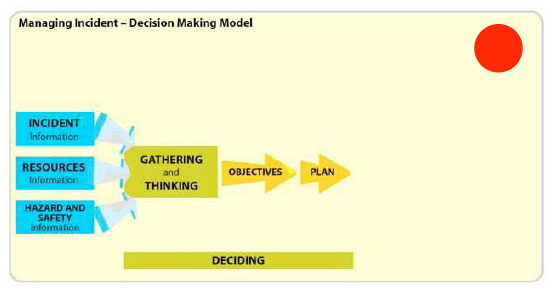
Identify and prioritise clear objectives that can be achieved within a safe and effective plan.
| Phase 3 - Actions |
|
|---|---|
| 3.1 |
Identify and prioritise objectives |
| 3.2 |
Develop tactical plan |
Considerations
Due to the large variation in incident scenarios and the many possible changes that will occur during a wildfire incident, it is difficult to outline a detailed tactical plan capable of meeting all potential wildfire scenarios. Nevertheless, wildfires will fall within four generic incident types which are:
- Those that have limited potential for fire spread across the landscape and can be quickly contained and extinguished
- Those that have limited potential for fire spread across the landscape and can be quickly contained but will take longer to extinguish
- Those that have the potential to spread over large areas of the landscape but can be contained through planned intervention
- Those that have the potential to spread over large areas of the landscape and are difficult to contain because at times they are beyond the control of available resources
Each of the generic wildfire types will require variations in the intervention response and resources allocated to ensure that they are effectively and safely managed.
3.1 Identifying and prioritise objectives
In order to identify objectives the Fire and Rescue Service Incident Commanders first action is to establish an understanding of what potential the fire has and the fire intensities that are likely to occur. In order to decide what objectives are to be achieved the following may have to be considered:
- Safety of all personnel
- Life risk
- Protection of property
- Prevent escalation of the incident
- Containment of the fire
- Mitigation of hazards
- Environmental considerations
- Implement an appropriate incident command system
- Resources required to achieve objectives from both the Fire and Rescue Service and other responders
- Prioritising tasks
3.2 Develop tactical plan
Having identified the objectives and priorities the tactical plan will need to be created, communicated and implemented.
The following should be considered:
- Declaration of a tactical mode
- Appropriate control measures and safe systems of work
- Allocation of tasks
- Comprehensive briefing of all personnel
- Available and required resources are sufficient to achieve the objectives
- Timely arrival of specialist tactical support (Aircraft, specialist teams, expert advice etc)
- The level of training and experience of personnel
- Inter-agency working and interoperability
Phase 4: Implementing the Tactical Plan
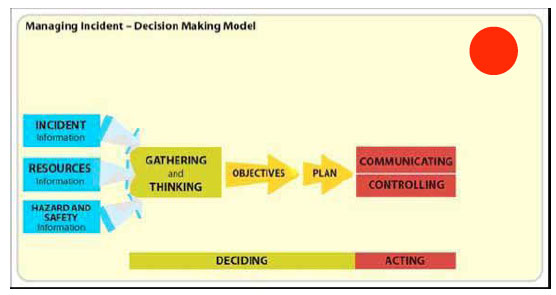
All relevant information must be communicated to FRS personnel and other responders, with their activities being controlled within a safe and effective tactical plan.
| Phase 4 - Actions Implementing the Tactical Plan |
|
|---|---|
| 4.1 |
Implement effective firefighting operations |
| 4.2 |
Communicate the tactical plan |
| 4.3 |
Implement deliberate reconnaissance to gather further incident information |
| 4.4 |
Communicating with other agencies |
| 4.5 |
Controlling the tactical plan |
Considerations
4.1 Implement effective firefighting operations
The operational environment at a wildfire incident will be challenging and dynamic and can be outside normal Fire and Rescue Service operations familiar to many personnel. Therefore particular care and consideration by the Incident Commander will be required when implementing the tactical plan.
Considerations should be given to:
- The likely duration of the incident
- The adoption of the LACES safety protocol
- The Wildfire Prediction System should be utilised
- Comprehensive and concise briefing to all personnel to maintain their situational awareness
- Consider the skills, knowledge, competency, of personnel allocated roles within the tactical plan
- Assessing the available resources and their capabilities
- The allocation of tasks should be based on the level experience, training and expertise
- Tactical plan needs to be realistic and achievable, balancing risk against benefit
- The plan should be based on expected fire behaviour
- Predicted fire intensities should be used to decide whether it is appropriate to use direct or indirect suppression tactics
- Plan may include the involvement of non-Fire and Rescue Service resources
- The plan needs to comply with Fire and Rescue Service standard operating procedures and Fire and Rescue Service policies based on the Generic Risk Assessment 3.4 Fighting fires in open rural areas
4.2 Communicate the tactical plan
The plan will need to be communicated to all Fire and Rescue Service personnel and other responders at the scene in line with Incident Command protocols and local standard
operating procedures:
- Confirm understanding of the tactical plan with Fire and Rescue Service personnel and broadcast tactical mode to all Service personnel
- Disseminate information to other personnel and confirm understanding with reference to the tactical plan and identified hazards of the incident
- Implement pre-arranged liaison protocols with other agencies
4.3 Implement deliberate reconnaissance to gather further incident information
Changes within the wildfire environment causes variations to fire behaviour and fire intensities, it is therefore important that sufficient information is gathered to allow control measures to remain effective throughout the incident.
In particular information should be gathered regarding:
- Wind speed and direction, air temperature, relative humidity and atmospheric stability
- The shape of the landscape
- The availability of fuel and its arrangement across the landscape
- Fire behaviour and intensities
Information can be obtained from:
- Observation from the ground
- Observation from the air
- Topographical maps
- Weather forecasts and modelling systems
- On-site weather monitoring
- Digital imagery systems
- Site plans
Additional information may be available from individuals including:
- Land managers/owners
- Fire group members
- Foresters
- Game keepers
- Farmers
4.4 Communicating with other agencies
To achieve a satisfactory conclusion many large wildfire incidents will require a multi-agency response. Historically both internal and external communications have been shown to be areas of weakness, therefore Fire and Rescue Service Incident Commanders should consider their methodology of communication with other agencies and co-responders.
The following are areas for consideration:
- Airwave radio system
- Correct allocation of radio channels
- Dedicated inter-agency radio channels
- Danger of reliance on mobile telephone networks
- The use of field telephones between emergency service control centres
- The use of runners
- The appointment of inter-agency liaison officers
- Pre-planned and agreed arrangements
4.5 Controlling the tactical plan
Once the tactical plan is in place, the Incident Commander will need to control its implementation to ensure that the objectives are met in accordance with the plan. Control is achieved by the use of the command structure that has been put in place.
Without effective communications control of the activities to meet the objectives will be compromised.
Phase 5: Evaluating the Tactical Plan
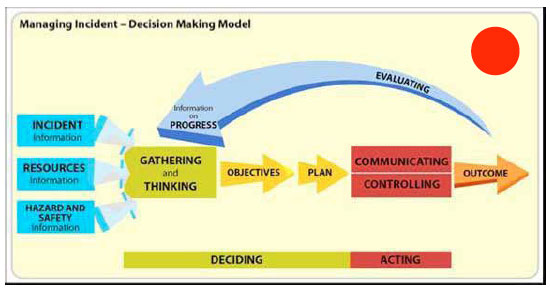
Fire behaviour at a wildfire can be extremely dynamic; it is essential that any potential situational changes which may affect the tactical plan are identified, and where necessary the plan revised
| Phase 5 - Actions |
|
|---|---|
| 5.1 |
Evaluate the effectiveness of the tactical plan |
| 5.2 |
Obtain and utilise specialist advice |
| 5.3 |
Assessment of systems of work |
| 5.4 |
Tactical plan not meeting objectives |
Considerations
5.1 Evaluate the effectiveness of the tactical plan
With all tactical plans there will need to be a continual review of priorities and objectives of the plan balanced against the risks being taken by Fire and Rescue Service Personnel and co-responders.
The following questions may be considered:
- Are personnel safe and are their welfare needs being maintained?
- Are the risks that are being taken by Fire and Rescue personnel and others proportional to the benefit?
- Have comprehensive analytical risk assessments been completed and appropriate control measures implemented?
- Are the resources appropriate and adequate to achieve the tactical plan?
- Do personnel in key roles have the skills, knowledge, competencies, and expertise to deliver the tactical plan?
- Is the selected Incident Command System effective?
- Has there been a change in the level of risks pertaining to the incident?
- Has the fire been contained or extinguished?
- Are the operational tactics effective and appropriate?
- Have the operational tasks achieved their objective in line with the tactical plan, if not why not and what needs to be altered to achieve the tactical plan?
- What are the environmental impacts of the tactical plan?
5.2 Obtain and utilise specialist advice
The range of expertise that is available to the incident Commander from rural sector experts should not be underestimated. These individuals can provide advice on matters that will assist in the formulation of a safe and effective tactical plan.
Any new information or unforeseen change in circumstances will require the Incident Commander to evaluate its impact on identified objectives and whether the tactical plan needs to be amended.
5.3 Assessment of safe systems of work
In the assessment of safe systems of work that are being undertaken by Fire and Rescue Service personnel and other responders, the following may need to be considered:
- Operational activities are being correctly monitored
- Actual fire behaviour is that which was expected or predicted
- The correct operational tactics are being used and that these are changed to meet expected variations in fire behaviour
- The measures defined within the LACES safety protocol have been implemented
- Personnel are able to maintain their understanding of the operational environment in which they are operating
- Personnel have the skills, competencies, training and experience necessary to remain safe
- If a safe system of work is not possible that personnel should be evacuated to a place of safety
5.4 Tactical plan is not meeting objectives
Evaluating the progress of the tactical plan against the considerations outlined in 5.1 will lead the Incident Commander to decide on the effectiveness of the tactical plan. If progress is not being achieved this will provide information for the Incident Commander to consider. A plan not meeting its objectives will need to be amended which may lead to:
- A decision to reallocate/re-task resources
- Request additional resources
- Change the prioritisation of the objectives
- Communicate changes to relevant personnel
- Is there a need to instigate an emergency evacuation of any/all personnel to a place of safety
Phase 6: Closing the Incident
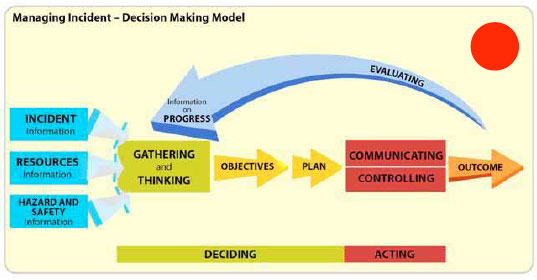
The objectives of the plan should recognise the importance of effectively closing down the incident and the proper management of post incident considerations.
| Phase 6 - Actions Closing the Incident |
|
|---|---|
| 6.1 |
Scaling down FRS operations |
| 6.2 |
Hand over control of the inner cordon |
| 6.3 |
Post incident issues |
| 6.4 |
Facilitate debriefs |
| 6.5 |
Post incident considerations |
| 6.6 |
Prepare and organise reports and documents |
Considerations
6.1 Scaling down Fire and Rescue Services operations
This is an important phase of the incident and one during which accidents and injuries are likely to occur, therefore there is a need to maintain the highest attention to command and control throughout this phase of operations.
The closing phase of a wildfire incident may take an extended period to complete, it is important that only an appropriate amount of Fire and Rescue Service resource is committed to this task.
Possible considerations include:
- Continued dynamic management of risk and a record of the Incident Commanders decisions
- Post incident security must be maintained
- Recovery of equipment and recording of those items that are missing or damaged
- Patrolling containment area and outer perimeter to prevent re-ignition or fire spread
- Mopping up of hot spots or deep seated fires
- Appropriate replacement of Fire and Rescue Service personnel and resources with those from partners and land management agencies
- Liaison with relevant agencies and authorities
- Personnel welfare
- Collection of appropriate data that may be required post incident
- Public access
6.2 Hand over control of the incident
Following the scaling down of Fire and Rescue Service operations the responsibility for the incident will need to be handed over to a responsible authority/person.
This may include:
- Land owner/manager
- Co-responder
- Police
- Local authority
- National Parks
- Military
- Relevant agency or authority
The Incident Commander will need to consider the following points upon hand over:
- Relevant risk assessments and identified hazards and controls
- Fire and Rescue Service post incident actions
- Arrangements for continued liaison and communication with those that remain at the scene
6.3 Post incident issues
Following a wildfire Fire and Rescue Service may have to provide information to:
- Local authority
- Insurance investigators
- Land managers/owners
- Utility companies
- Police
- Environmental agency
It is therefore important that the Incident Commander keeps a record of Fire and Rescue Service actions.
It is also essential that all necessary information has been collected to ensure accurate completion of fire reports and statistical data.
6.4 Facilitate debriefs
Debriefs play an important part in promoting improvements in personal and organisational performance and should take place whenever there is an opportunity to improve standards of service delivery. Such post-incident reviews may be informal or formal. They can range from something as simple as an on scene 'hot debrief', to a large multi-agency debrief or a Public Enquiry following a major incident.
The format chosen for the debrief should be appropriate to the nature of the wildfire incident attended, and the level of involvement of partner agencies and other responders. In order to both embed and improve wildfire procedures, it is essential that wildfire debriefs be conducted in a manner that promotes open, supportive and constructive discussion of all aspects of the incident.
As with any other incident debrief, risk-critical issues highlighted during post-incident wildfire reviews should be addressed immediately through review of personal performance, equipment, working practices or systems.
Following a wildfire incident, significant information gained, or lessons learned, may relate to a number of areas including:
- pre-planning
- partnership working
- appropriateness of fire plans
- multi-agency response arrangements
- existing operational intelligence information
- personal protective equipment
- the provision and use of equipment
- safe systems of work
- FRS and partnership training
- levels of safety supervision
All noteworthy action points or learning outcomes must be fed back into the policy and procedures of the brigade highlighting equipment, systems or procedures which did NOT work satisfactorily, or which made the working environment unsafe. It is equally important to highlight any unconventional system or procedure used which was successful or made the working environment safe.
Where a formal post-incident review is required it should be held at a venue that is suitable and convenient for those to be invited to attend. Copies of relevant documentation should be available and provision made for recording proceedings, outcomes and learning points. Notes of the outcomes and details of action taken, or planned, to address the learning points raised should be made available to the relevant people as soon as practicable.
6.5 Post-incident considerations
The majority of fire service focus and activities centre around the pre-planning and emergency phase of a wildfire incident. However, there are issues which may involve the fire service far beyond the closure of the emergency phase.
Examples include the following:
- Post-mortem enquiries and coroner's hearings
- Fire investigation
- Accident investigation
- Public or judicial enquiries
- Litigation
- Financial costs to the brigade, i.e. damaged equipment
- Criminal investigation
- Incident debriefing and evaluation
- Media
- Potential national implications
The Incident Commander (or nominated personnel) must, at the earliest convenient time, attempt to assess what the post-incident wildfire considerations might be. On the basis of this assessment, the following tasks might need to be undertaken:
(i) Scene preservation
(ii) Recording and logging
(iii) Impounding equipment
(iv) Identification of key personnel
(v) Managing the closure of the incident
(vi) Liaison with partner agencies
6.6 Prepare post-incident reports and documents
Depending on the size and scale of an incident investigations may require a range of reports and documents to be prepared by the Fire and Rescue Service. These may include:
- Internal and multi-agency debriefs
- Statements from the Fire and Rescue Service
- Records, recordings and transcripts of incident activities
- Fire investigation
- Reports for police/coroner/public enquiry
- Photographs/Video
- Records related to the decision-making process
FRSs should ensure that appropriate emphasis is given to wildfire fire investigation. In order to ensure that a resilient and robust record of wildfire events can be developed locally, regionally and nationally, it is important to secure, as far as reasonably possible, information relating to:
- The point of origin of the wildfire
- The cause of the wildfire
- The extent and area of the fire 'footprint'
- Environmental impact
- The extent of damage to habitat, wildlife and property.
- Records of any fatality or injury
- Criminal activities
- Estimated costs of the incident
- Any extreme or unusual fire behaviour
Contact
Email: Dean Cowper
There is a problem
Thanks for your feedback